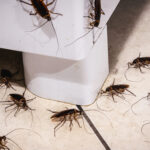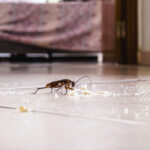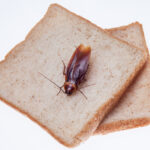How Can We Help?
What are the biggest risks and dangers of allowing a cockroach infestation to grow out of control?
Allowing a cockroach infestation to grow out of control poses significant risks and dangers to both health and property. One of the most serious health risks is the potential for disease transmission. Cockroaches are known to  carry various pathogens, including E. coli and Salmonella, which can possibly cause food poisoning and other gastrointestinal sicknesses. As they crawl through unsanitary areas, such as rubbish, sewers, and decaying matter, they pick up and spread these pathogens to food, kitchen surfaces, and utensils.
carry various pathogens, including E. coli and Salmonella, which can possibly cause food poisoning and other gastrointestinal sicknesses. As they crawl through unsanitary areas, such as rubbish, sewers, and decaying matter, they pick up and spread these pathogens to food, kitchen surfaces, and utensils.
Property damage is another significant concern. Cockroaches are notorious for chewing through various materials in search of food. They can damage wallpaper, books, clothing, and even electronics by gnawing on wires and insulation. This can turn into costly replacements and repairs, and even potential fire hazards if electrical wiring is compromised.
Furthermore, a large cockroach infestation can severely impact the psychological well-being of residents. The sight of cockroaches scurrying across floors and walls can induce feelings of disgust, anxiety, and helplessness. The stress of dealing with a persistent infestation can lead to sleep disruptions and reduced quality of life.
An uncontrolled cockroach infestation can also affect a home's structural integrity. Cockroaches often hide in cracks, crevices, and behind walls, contributing to the deterioration of these spaces over time. The presence of these pests can also attract other vermin, such as spiders and rodents, compounding the infestation problem.
Can cockroach infestations attract other pests and create secondary infestations?
Yes, cockroach infestations can indeed attract other pests and lead to secondary infestations. Cockroaches create an environment that is conducive to the survival and proliferation of other pests due to their behaviors and the conditions in which they thrive. One primary way this occurs is through the food sources and residues left behind by cockroaches. Cockroaches are omnivorous scavengers that feed on a huge range of organic matter, including food crumbs, grease, and even dead insects. They contaminate food items and surfaces with their saliva and feces and shed skins, which can attract other pests seeking food and shelter.
For example, rodents such as mice and rats are lured to the same food sources as cockroaches. They may be drawn to homes with established cockroach populations, finding easy access to food and water that cockroaches have left behind. Additionally, rodents can follow the scent trails and pathways created by cockroaches, further facilitating their entry and infestation.
Similarly, cockroach infestations can attract other insects, such as ants and flies. These pests are also attracted to food residues and decaying organic matter that cockroaches leave behind. Ants, in particular, may establish trails and nests near cockroach activity, exploiting the resources available in the environment.
Moreover, the presence of cockroaches can indirectly contribute to conditions that support secondary pest infestations. Cockroaches often hide in dark, warm, and humid places such as behind appliances, in cabinets, and within wall voids. These hiding spots can provide shelter and nesting sites for other pests seeking refuge from predators or adverse environmental conditions.
How do cockroach infestations impact a home's cleanliness and sanitation?
Cockroach infestations can have a profound impact on a home's cleanliness and sanitation, posing significant challenges to maintaining a healthy living environment. One of the primary worries is the contamination of food and food preparation surfaces. Cockroaches are scavengers that feed on a wide range of organic matter, including food crumbs, grease, and even rubbish. They contaminate these food sources with their saliva and feces and shed skin, which can harbor bacteria, pathogens, and allergens. This contamination not only renders food unsafe for consumption but also compromises the overall cleanliness of kitchen surfaces and utensils.
challenges to maintaining a healthy living environment. One of the primary worries is the contamination of food and food preparation surfaces. Cockroaches are scavengers that feed on a wide range of organic matter, including food crumbs, grease, and even rubbish. They contaminate these food sources with their saliva and feces and shed skin, which can harbor bacteria, pathogens, and allergens. This contamination not only renders food unsafe for consumption but also compromises the overall cleanliness of kitchen surfaces and utensils.
Additionally, cockroaches contribute to unpleasant odors in the home. Their secretions and fecal matter emit a distinct, musty odor that can permeate areas where infestations are concentrated. This stench can be persistent and difficult to eliminate, even with thorough cleaning efforts.
Cockroaches also leave behind visible signs of their presence. Their droppings, which resemble pepper or coffee grounds, may accumulate in hidden corners, behind appliances, and in cabinets. These droppings not only detract from the home's cleanliness but also serve as a potential allergen source, exacerbating respiratory issues for sensitive individuals.
What are the long-term health effects of chronic exposure to cockroach infestations?
Chronic exposure to cockroach infestations can have significant long-term health effects on individuals, particularly those living in affected environments. One of the most serious health concerns is the exacerbation of respiratory conditions. Cockroaches produce allergens in their saliva and feces and shed skin that can cause allergies and asthma attacks in susceptible. Prolonged exposure to these allergens can lead to the development or worsening of asthma symptoms, such as wheezing, coughing, and shortness of breath. Children, the elderly, and people with pre-existing respiratory conditions are especially vulnerable to these effects.
Furthermore, the psychological impact of living in a cockroach-infested environment can be profound. The presence of cockroaches can cause stress, anxiety, and feelings of disgust among residents, affecting their overall mental well-being and quality of life. The constant stress about health risks and the stigma associated with infestations can also lead to social isolation and reduced enjoyment of home life.
 Over time, chronic exposure to cockroach allergens and pathogens can weaken the immune system, making individuals more susceptible to infections and other illnesses. This can further compromise overall health and contribute to a cycle of recurring health issues in affected households.
Over time, chronic exposure to cockroach allergens and pathogens can weaken the immune system, making individuals more susceptible to infections and other illnesses. This can further compromise overall health and contribute to a cycle of recurring health issues in affected households.
Addressing cockroach infestations promptly and effectively is crucial to mitigating these long-term health effects. Integrated pest management strategies that combine sanitation practices, sealing entry points, and targeted insecticide treatments are essential for eliminating cockroaches and reducing allergen exposure. Regular monitoring and maintenance by professionals like us here at Youngs Pest Control are also important to prevent infestations from recurring and safeguard the health and well-being of residents.
